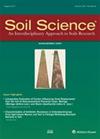利用茶包指数(TBI)配对凋落物分解与微生物群落结构
4区 农林科学
Q2 Agricultural and Biological Sciences
引用次数: 7
摘要
摘要将有关土壤微生物群落的信息纳入全球分解模型对于预测和理解生态系统功能如何响应全球变化而发生变化至关重要。在这里,我们结合了一个标准化的凋落物袋方法来估计分解率,茶袋指数(Tea bag Index, TBI),以及在袋中定植的植物凋落物的微生物群落的高通量测序。与奥地利克洛斯特纽堡联邦葡萄栽培和水果种植学院的学生一起,作为公民科学家,我们使用这种方法调查了埋在三种不同土壤类型和四季中的顽固(路易波士)和不稳定(绿茶)植物凋落物的原核生物和真菌的多样性,目的是(i)比较土壤类型和季节之间凋落物的分解[分解率(k)和稳定因子(S)];(ii)比较不同土壤类型和季节下易变和难变凋落物的定殖微生物群落;(iii)将微生物多样性和定殖菌类群相对丰度模式与凋落物分解率(k)和稳定因子(S)相关联。稳定因子(S)与季节相关,但与分解率(k)无关,在夏季显著降低。这一发现强调了在确定分解动力学的努力中包括寒冷季节的必要性,以便准确地量化土壤中的养分循环。通过我们的方法,我们进一步证明了来自土壤的真菌和原核分类群对植物凋落物的选择性定植。这些微生物的群落结构在夏季和冬季之间差异最大,路易波士凋落物通常比绿茶凋落物具有更强的选择力。此外,该研究表明,真菌降解物与原核降解物对于顽固和不稳定的植物凋落物的分解具有同等的重要性。我们的结果共同证明了在多个季节分析分解动态和分离微生物群落活性成分的影响的重要性。本文章由计算机程序翻译,如有差异,请以英文原文为准。
Pairing litter decomposition with microbial community structures using the Tea Bag Index (TBI)
Abstract. Including information about soil microbial communities into global decomposition models is critical for predicting and understanding how ecosystem functions may shift in response to global change. Here we combined a standardised litter bag method for estimating decomposition rates, Tea Bag Index (TBI), with high-throughput sequencing of the microbial communities colonising the plant litter in the bags. Together with students of the Federal College for Viticulture and Fruit Growing, Klosterneuburg, Austria, acting as citizen scientists, we used this approach to investigate the diversity of prokaryotes and fungi colonising recalcitrant (rooibos) and labile (green tea) plant litter buried in three different soil types and during four seasons with the aim of (i) comparing litter decomposition [decomposition rates (k) and stabilisation factors (S)] between soil types and seasons, (ii) comparing the microbial communities colonising labile and recalcitrant plant litter between soil types and seasons (iii) correlating microbial diversity and taxa relative abundance patterns of colonisers with litter decomposition rates (k)and stabilisation factors (S). Stabilisation factor (S), but not decomposition rate (k), correlated with the season and was significantly lower in the summer. This finding highlights the necessity to include colder seasons in the efforts of determining decomposition dynamics in order to quantify nutrient cycling in soils accurately. With our approach, we further showed selective colonisation of plant litter by fungal and prokaryotic taxa sourced from the soil. The community structures of these microbial colonisers differed most profoundly between summer and winter, and rooibos litter was generally a stronger selector than green tea litter. Moreover, this study indicates an equal, if not higher, importance of fungal versus prokaryotic degraders for recalcitrant and labile plant litter decomposition. Our results collectively demonstrate the importance of analysing decomposition dynamics over multiple seasons and isolating the effect of the active component of the microbial community.
求助全文
通过发布文献求助,成功后即可免费获取论文全文。
去求助
来源期刊

Soil Science
农林科学-土壤科学
CiteScore
2.70
自引率
0.00%
发文量
0
审稿时长
4.4 months
期刊介绍:
Cessation.Soil Science satisfies the professional needs of all scientists and laboratory personnel involved in soil and plant research by publishing primary research reports and critical reviews of basic and applied soil science, especially as it relates to soil and plant studies and general environmental soil science.
Each month, Soil Science presents authoritative research articles from an impressive array of discipline: soil chemistry and biochemistry, physics, fertility and nutrition, soil genesis and morphology, soil microbiology and mineralogy. Of immediate relevance to soil scientists-both industrial and academic-this unique publication also has long-range value for agronomists and environmental scientists.
 求助内容:
求助内容: 应助结果提醒方式:
应助结果提醒方式:


